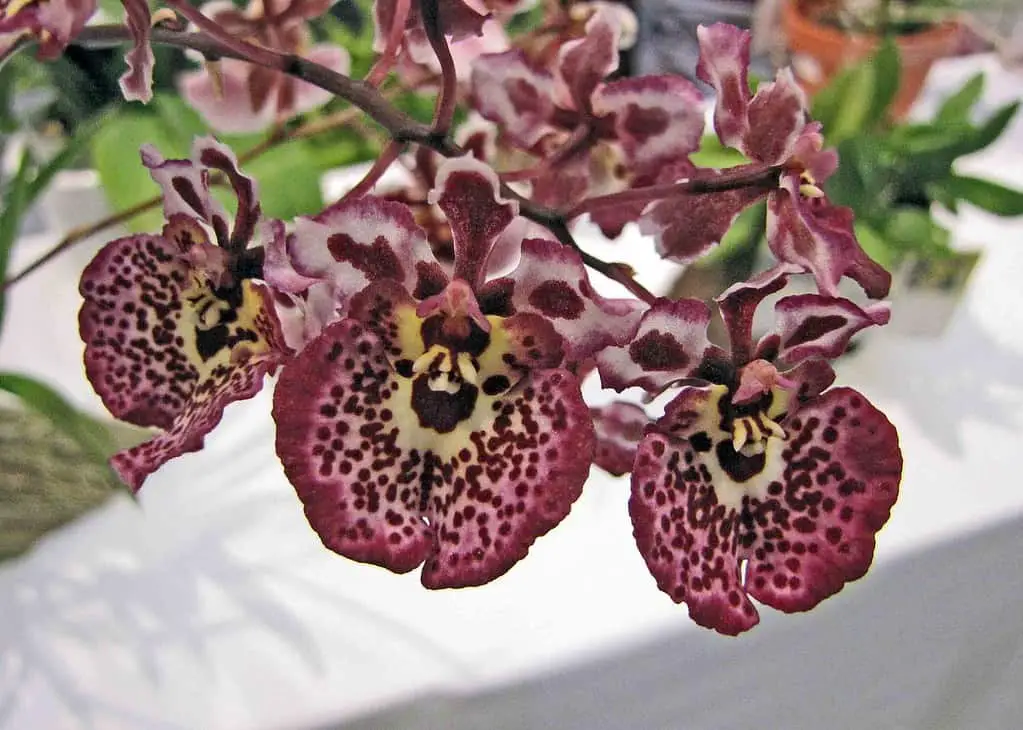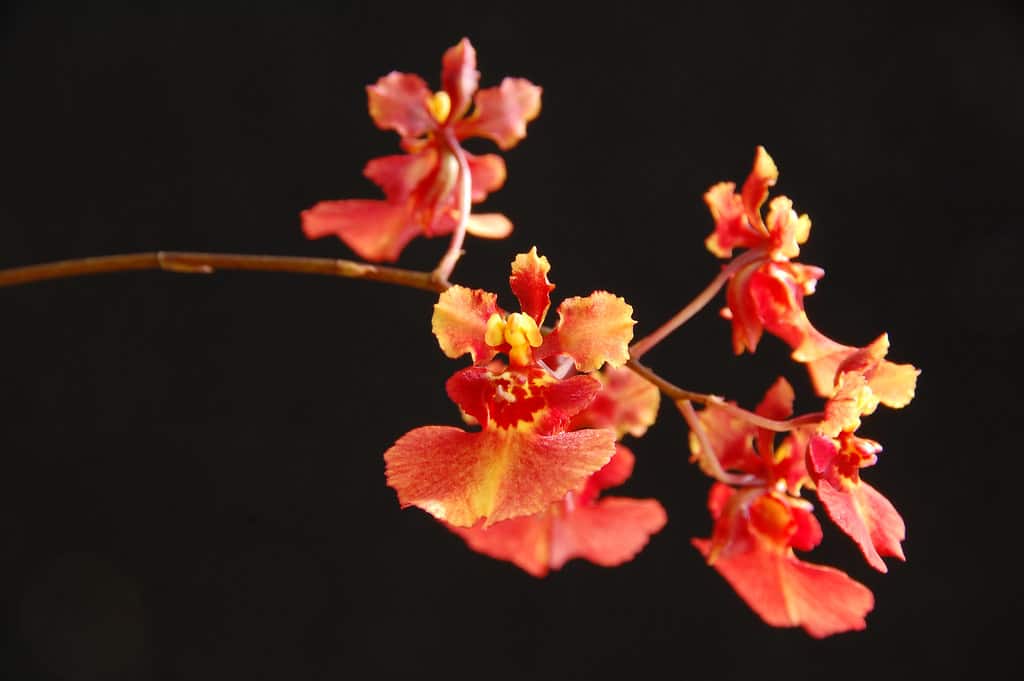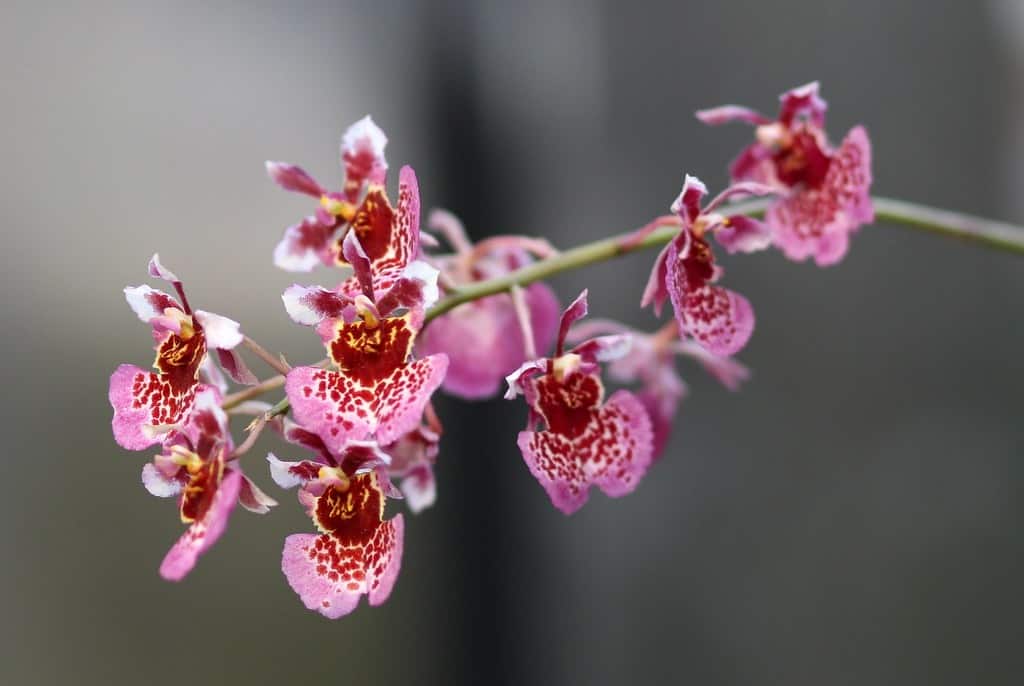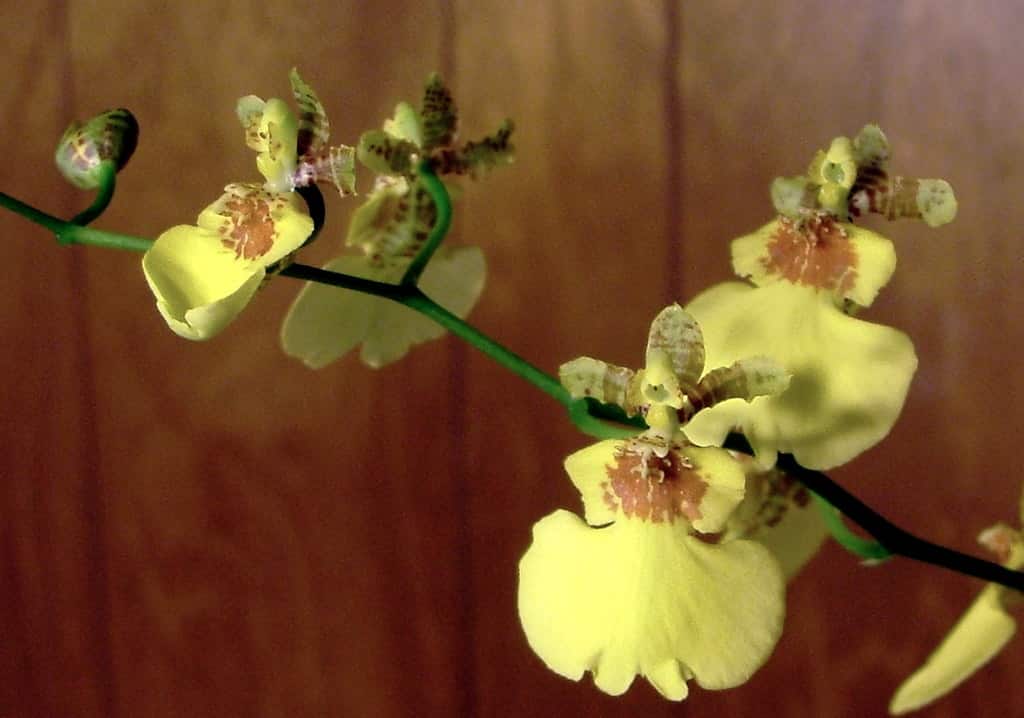One of the biggest surprises I had after starting my hobby as an orchid grower was when I ordered my first Tolumnias online. Being familiar with Oncidium orchids, I was expecting something very similar.
Even though the seller had specifically mentioned that their pot was 1.5 inches, (3.8 cm) I had no idea how small Tolumnia orchids were until the unboxing. Thinking I got screwed by my vendor, I launched into my search and research about Tolumnias only to find out I was wrong about them.
They are that tiny but their flowers are well worth it. Now that I had a whole bunch of these orchids—I classify them as miniatures but some people don’t due to the size of their flowers—I had to learn what to do with them.
After all, how do you grow Tolumnia orchids?
Tolumnia orchids differ in their care and culture from regular Oncidiums, preferring humid climates (50 to 80% RH) and temperatures from 55 to 90 F (17 to 32 C). Although they don’t have pseudobulbs, they can’t tolerate wet roots or overwatering.
Tolumnias grow best in between 2,000 – 3,000 fc, placing these equitant orchids in the medium to high light orchids category. Air movement is fundamental when growing Tolumnia orchids since they do not withstand wet roots for more than 24 hours.

How Tolumnia Orchids “Became” Equitant Orchids
First classified and cataloged in 1836, Tolumnias were originally submitted into Oncidium section variegate, a subcategory under the larger genus of Oncidiums. Oncidiums in general prefer tons of humidity and a slightly cooler temperature compared to Phalaenopsis, but these equitant orchids do not.
Unlike other Oncidiums, Tolumnias also don’t have a pseudobulb, which makes storing water and nutrients impossible. This is important later on in this article, so please take note of that.
Due to their small size, no pseudobulb, and specific growing needs that differ from most Oncidiums, Tolumnia orchids were denominated the Equitant Orchids.
What does Equitant mean? Equitant comes from the Latin, related to horses. Since the Latin has given away, Equitant has slipped into botanical life as a term meaning “overlapping each other transversely at the base (as in an iris)” (Merriam-Webster’s definition ).
).
Since the leaves on the Tolumnia orchids overlap each other, as if mounted on top of each other straddling the older leaves, their name derives from the idea of a rider straddling his horse when riding. Each cluster of leaves rides on top of the other group and Tolumnias grow in clusters, not spread out.
If you speak a Latin language, you might have guessed that definition due to “equitação” in Portuguese, or “equitación” in Spanish. Both translate as the hobby of horse riding.
Tolumnia is not a new name in literature. In Roman mythology, and ancient poet Publius Virgilius Maro (70-19 BC) mentioned the name Tolumina referring to a Rutulian nymph (Tolumnius). In this summary of the epic poem called Aeneid, Tolumnius appears in the 12th book.
Here’s a summary:
“Just then, they see an eagle – considered to be the bird of Jupiter – swoop down and seize a swan. Then, a whole bunch of other seabirds attack it in group formation; eventually, the eagle is forced to release the swan and beat a retreat.
Tolumnius, the augur (a soothsayer who interpreted the movements of birds), says that this is a sign that they should back up Turnus.
Then Tolumnius himself throws his spear at the Trojans. The spear kills one of a group of nine brothers all standing together. Predictably, the other brothers grab their weapons and race forward for revenge. In no time, both armies are fighting again.” (Source )
)
That is probably the taxonomists’ initial source of inspiration for Tolumnia orchids. But enough of Greek mythology and Literature, right?

Tolumnias in Nature and Their Natural Habitat
Not having a pseudobulb implies that Tolumnia orchids need to be watered frequently but they live in dry climates. This is how oddly strange they are, but ever so fascinating.
Without a storage unit, they will shrivel up and die within a few days if left dry too long. Yet when watered, their tiny sensitive roots are prone to root rot if kept wet overnight. This dry/wet combination is extremely crucial to their culture and growth and is easiest to understand that when you look at where they grow.
Tolumnia orchids grow around many islands of the Caribbean and West Indies. Some Tolumnias grow indigenously on one crucial island, either Cuba, Jamaica, Bahamas, Haiti, Dominican Republic, Hispaniola, while other Tolumnia species are found on all of them and can reach as south as the northern tip of Brazil.
There are about 30 species in all, growing in between the sandy beaches but not yet penetrating the forest jungles. They like to be somewhat near—but not too close—to the ocean.
They thrive in dry soil and humid air.
I want you to imagine a vacation spot on a tropical island, with constant warm breezes as you tan in the sun on the hot, salty beach. In the afternoon it usually rains, but a quick, soft rain that does nothing to cool down the hot and sticky weather, but raises humidity quite a bit.
As you walk back to your hotel from the beach, you see the scarce coastal vegetation slowly start to thicken with more palm and coconut trees, short grasses, and thicker shrubs. As soon as you reach the city streets, less than a few miles away, you’ll find Tolumnias growing closer to the ground but still epiphytes.
They will attach to tiny tree branches and small twigs (not the main tree trunk) and also rocks, classifying them as both epiphytes and lithophytes.
They usually grow under larger growing plants, so even though they like the sun, the shady hours of the day that sun is dappled upon them is incredibly long and the rays are fierce. This classifies them as low light orchids, but if left in brighter light they also grow well. Adapt them slowly, and they’ll grow fine.
Since they have a rhizome that travels out, they are also classified as stoloniferous plants, which means “A horizontal stem that is located above the ground and usually produces adventitious roots and vertical stems at the nodes. Stoloniferous refers to a plant that bears stolons.” (Source )
)
Stoloniferous usually comes to mind when we think of impenetrable grasses, or worse—weeds, that form a thick cluster of growth.
About weeds—I have to mention this fact which I found rather funny. Around 1950, one grower of Tolumnia orchids, Gooldale Moir, was fascinated by these orchids. His colleagues, however, thought they were weeds and didn’t share his passion. Much to the contrary, they thought he could spend more time researching other orchids. By 1970, he was a well-known breeder and published articles about Tolumnias. Weeds are sometimes not what we think. Source: Steven A. Frownie and National Gardening Association in the book Orchids for Dummies which you buy here . (Affiliate Link). Despite the book’s name, which I find personally offensive, the information in the book is really good.
. (Affiliate Link). Despite the book’s name, which I find personally offensive, the information in the book is really good.
As so-called “weeds”, Tolumnias will do the same and grow in impassable, dense clumps. Even though the rhizome travels out producing vertical clusters, they never travel far. This turns them into a thick, impenetrable cluster of leaves, hardly ever outgrowing their pots. For us as indoor orchid growers, that’s great because they save space.
These tropical-island orchids love humidity, which is why they don’t need a pseudobulb. When it rains, the water quickly trickles off their tiny roots, leaving them to dry. The year-round higher temperatures and the constant airflow coming from the ocean maintains them dry most of the time, even though it rains almost daily. If it doesn’t rain in a few days (four or five), these orchids will wither quite quickly.
The secret to having these orchids grow well is to keep the humidity high around them.

Care and Culture of Tolumnia Orchids
Once you get over the initial shock of how small they are, now it’s time to learn how to properly care for them, which is why you probably came to this article in the first place.
I like to add the section above about orchid’s natural habitat because if you can recreate that inside your home, you’re well on your way to a great hobby. In each section below, imagine the same natural conditions of these islands, and imitate those conditions to the best possible.
1. Tolumnia thrive in high Humidity
Keep the humidity high—that’s the real secret of growing Tolumnia Equitant orchids. Without the pseudobulb, these orchids will need something to keep the water around them well preserved, and that always helps with the higher humidity.
Since you shouldn’t be watering these orchids a lot (they’re prone to root rot) that leaves you with another way to provide water that isn’t direct watering—raise the humidity. If you can, the humidity should be in between 50 and 70%.
This does require a humidifier in most cases unless you live in a very humid climate. Since I don’t, (my orchids are in my home office) I had to buy a humidifier and I chose this one. (Affiliate Link) I kept notes on how that search went and detailed the various types of humidifiers in this article.
I kept notes on how that search went and detailed the various types of humidifiers in this article.
I highly recommend it since I couldn’t grow my orchids without a humidifier and it will help you chose the right one for you.
2. Correcting the Temperature for Tolumnia Orchids
These orchids like it hot. They are classified as warm-growing orchids but can tolerate intermediate conditions. This means they prefer 55 to 90 F (17 to 32 C).
I keep mine around 74 to 80 F (23 to 26 C) during the day and drop that at night to 70 (21 C). It’s not required at all, unlike the Phalaenopsis or Dendrobium orchids, that prefer to have that drastic nightly drop. This temperature change stimulates the reproductive cycle to kick in and produce that flower pike we all love.
Except Tolumnias don’t share that same habitat. Where they live naturally, the temperatures do not drop as much during the night, staying relatively hot at night too.
Remember that tropical vacation I mentioned earlier?
Just think of what you’d do at night. You’d probably keep your fan or AC, the same way it was on during the day just because the temperature doesn’t drop that much.
3.Tolumnia Under Lights: Indoor Light Requirements
Since these orchids grow in the sun but under a tree, they’re classified as both high light orchids (3,000 + fc) and medium-light orchids (2,000 – 3,000 fc). They will grow better in medium light since they won’t have to use part of their energy to create a natural sunscreen (the reddish-purple dots on the top leaf) called anthocyanin. Once they have accustomed to the higher lights, they will grow just as well as the medium light requirements.
One interesting tip: the huge flowers on the Tolumnia are made that way to protect their leaves from the sweltering overhead sun. They are prolific bloomers and seem to always be in bloom. This way they can protect the harsh rays from baking the leaves by producing humongous flowers. That is the reason the flowers are “unproportionally” sized to their base.
When you first unbox these orchids, they will seem tiny. You’ll probably be wondering if the flower is worth it, or if the sellers zoomed in the image, enlarging the flower 1000 x just to make a sale. Be patient, and you’ll be rewarded with beautiful big blossoms, and now you know why they are so big (compared to their small leaves and rhizomes).
In my home office, I have them on the second shelf from the top, right next to a few other Oncidiums. They won’t tolerate as much as Vanda or Cattleya orchids will, but prefer more than the Phalaenopsis.
If you are using windows instead of artificial lights, chose one that has ample morning sun, especially slightly before noon. If just a few rays come through during morning hours, your Tolumnia probably won’t flower. Any afternoon sun that lasts for more than an hour will burn the leaves. If you grow them outdoors (which I don’t) you’ll need to use a 50% shade cloth, to protect the leaves from the sun.
Another tip for growing Tolumnia orchids on the window sill is that they would prefer the temperatures in the south-facing window (if you live in the Northern hemisphere). Even if I had a good window for the sun requirements, I don’t think I could match the temperature & sun together.
It’s a tricky combination since you have to be hot but not too bright.

4. The Best Tolumnia Orchid Potting Medium
Tolumnias will do extremely well on mounts or in baskets. This is because they love to dry out and don’t like that much water. Open hanging baskets make the best “pots” for Tolumnias. To illustrate from Amazon, this is what I’m talking about (Affiliate Link). Don’t be fooled by the basket size-tiny is better. They don’t grow that much anyway.
Don’t be fooled by the basket size-tiny is better. They don’t grow that much anyway.
If there are only larger baskets in your area, don’t worry. You can plant 2 Tolumnias together in the same basket since they won’t compete with other orchids for nutrients.
Just don’t add another orchid to the basket that isn’t a Tolumnia. It will certainly lose this battle and die on you while the larger rooted orchid will thrive. You can read more about planting 2 orchids in the same pot in this article I wrote.
As for what to put inside the basket, I don’t suggest bare-rooted, as you would a Vanda. The roots on the Tolumnia are very shallow and will fall to the bottom of the basket if not propped up.
Layer the bottom ½ or bottom ⅓ with one or several of the following:
Types of Potting Media for Tolumnia Orchids
- coconut chips
- lava rock
- stone pebbles
- large chunked charcoal
- tree bark
- cork pieces
- pumice
- leca pebbles

Whatever you use, you want this layer to not retain any moisture since the roots need to be dry before nightfall. It has to be fast-draining, more so than any other orchid you’ll own.
One tip on choosing the rocks that you can use: don’t select dark-colored rocks. These will heat up under the lights and raise the temperature around the tiny, sensitive roots.
They can’t handle the higher temperatures around the roots and will die. If the rock is a lighter color, the high light requirements can be fulfilled since the rays will reflect off the pebbles.
Another point to think about is the size of the potting media. In general, I have a rule that for small, tender roots, I chose a small, fine-grade tiny pieces of bark. The larger the roots, the larger the pieces of media I choose.
This is not true for selecting the right potting media for Tolumnia. These tiny roots need to dry out quickly, so the fine-grade bark will retain the moisture and not allow this to happen. The pot needs to be dry before nightfall.
As for my 100% go-to potting media which is sphagnum moss, I hardly use it all when potting Tolumnias. I will use a tiny bit since my home office is extremely dry and I can’t always water every day, but in terms of quantity, I hardly use any at all.
If you can, mount Tolumnias. This is my go-to option for Tolumnias because they can dry out faster and have plenty of air movement. Sometimes after mounted, you’ll be tempted to hang them up on a wall, with no airflow from the back of the mount.
This can cause problems since the best place for them is where air can flow from all sides. If you have a metal wire fence or can hang them on the edge of the shelf, where air can reach all sides of the mount, your Tolumnia will survive better.
On my list of articles to write is one about mounting Tolumnia orchids. Later I’ll come back and leave a link here so you can read about that.
One last thing about the potting media for Tolumnias: for their tiny size, chose a sturdy pot. These orchids have huge flowers that weigh a lot compared to the main plant. Terracotta pots will work well if they have plenty of holes in them. The pendant flowers will hang down if not staked, and these need the extra support.
5. Tolumnias need a constant watering cycle
This is the main problem with the Tolumnia orchids: getting the watering schedule just right. It’s hard to manage at first, because these orchids like humid climates but prefer dry roots, living in habitats with lots of humidity in the air, daily quick rains, and hot winds that dry up the roots quickly.
Without pseudobulbs, you can’t forget to water these orchids. Even though they like to dry out, without the typical Oncidium pseudobulb, these orchids won’t stand a chance after 7 days of complete dryness.
If you have your Tolumnia orchid mounted, you’ll need to mist daily and verify that is completely dry before night. If your Tolumnia orchid is in a pot, then you need to keep the roots dry after the first day of watering. If they are still wet on day 2, you need to wait.
Do not water if you’re not sure about the water retention in your pot. It’s better to let them dry out another day than to water them again when they don’t need it.
Tolumnia Blooming Season & Flowers
Tolumnias seem to always be in bloom, displaying a gorgeous bouquet of pendant flowers. Of course, every species will have its preferences, and some only bloom once a year during spring, but as for the majority, they will seem to always have flowers on them.
Even the prolific bloomers need a period of rest, and this usually coincides with the winter months. They will go dormant, but won’t lose their leaves like Dendrobiums will.
These orchids will need less water and no fertilizer during these months, which where I live, are usually November to February. During this rest period, you can go without watering for up to 10 days, but don’t hesitate to mist every once in a while, to keep them alive.
Because they are such prolific bloomers, don’t ever cut the flower spikes. We usually learn with Phalaenopsis orchids that cutting the spike is preferential after the blossoms have fallen off, but Tolumnias will often use the same spike to produce another bloom in a few months. The need to keep these flowers open and blossoming to protect their leaves, as I mentioned before.
The fragrance isn’t that noticeable on most Tolumnias, but sometimes a species will surprise you. For example, the Tolumnia variegata usually is. I’ve read that Genting Pink Lady is also fragrant.
Dividing and Repotting Tolumnia
There is one thing that Tolumnias dislike more than cold wet weather and that is being repotted. They rely on their roots and short rhizomes to maintain stability, so when you repot them, they get disturbed beyond the point of forgiveness.
If these orchids could have human emotions, the period after repot would most likely be compared to the silent treatment. They just sit there, not growing, not producing new leaves, no new roots… just sitting there silent.
Once they have made their point and they decide that you will not repot them again, they continue growing as they had before. Of course, this is psychology mixed into botany (which doesn’t mix), but I thought that in this case, the comparison worked well.
When you divide them, make sure they have at least 8 leaves together in one clump. Since they do not have pseudobulbs, they depend on their leaves to store the nutrients and water that they need until new roots are developed. Repotting them will stun them, and they adapt rather poorly to new environments or any potting changes.
By maintaining a lot of leaves linked by a rhizome, you will make sure they are still being helped by neighboring leaves and have some sort of storage, even if it is low. With less than 8 leaves, they consume the leaf’s storage of water and nutrients before they have had time to adapt and most likely will die.
The best time to repot is right after the blooms have fallen off, which coincides with the initial stages of winter (for most Tolumnia). They will be going into a small dormancy period which is hard to tell since they don’t have the leaf drop or other characteristics of dormancy.
When you repot, always use a shallow pot with high draining media. The roots will not grow down into the media, but rather out to the sides. This is because rainfall will not last long and not penetrate the soil that deep. The shallow roots need to capture the water while it’s still there, making the most of the humidity before it evaporates by night.
In all, knowing where Tolumnias grow in nature is the best way to imitate these conditions at home. With a high humidity of around 50 to 70, medium to high light requirements, a potting media that portrays extremely fast drainage, and light fertilizer every 2-3 weeks, your Tolumnia orchids will grow very well inside your home.
Don’t Stop Learning!
If you want to be included in more information and get a 14-page fertilization guide, please sign up for my newsletter. I don’t spam, but send emails out bi-monthly with some curious topics of interest. If you want more information, click here to go to a specific page on this website where I explain it more in detail.

Also, if you are looking for an orchid journal to keep your notes specifically about orchid care, check out my 2 solutions for that on this page. If note-keeping isn’t your thing, then there is a free excel spreadsheet that you can download. Click here for more information on how to do that.
If you subscribe to my newsletter, I will send you a 14-page guide on the main tips of orchid fertilizer. It is downloadable and you can print it out on your computer. I designed the guide to double up as a coloring book, just to make it fun.
I wish you the best in your orchid care and happy cultivating.


It’s third time I will make a comment about Tolumnia.
I am an orchid lover and learned a lot from your article.
Thanks for your valuable information.
Hi Uma Sankar Banerjee,
Third time? I’ll look into why I’m seeing this only now as the first comment. Sometimes my anti-spam finds a comment and for some reason it thinks that it is not supposed to be there. I had a lot of comments removed once before I realized my anti-spam was separating all the comments with the word “pot”. I guess it thought the person was trying to sell me weed. After I went back and manually told it to not delete comments like that, I got a lot more comments. That might have been the problem (some other word is getting caught in the anti-spam bot).
Anyway, thank you for your comment. I appreciate it!
-Amanda
Thank you for the info on these little orchids . I like these little dancing lady blooms.🙂 Im going to give them a try,and see if they like Georgia’s weather. Thanks again for great reading material. I think I’ve just about read it all.
Ps. I also love coffee.. Morning , noon or night or any other time in between. Hubby was raised in Guatemala as his folks were missionaries there for 8 years.. their coffee habits wore off on me.
Hi Deb Bear,
Wow, Thank you for your comment. I appreciate it.
-Amanda
I enjoyed reading your article. Great growing tips, thanks! Do you have any new pics?
I live in a climate that is perfect for these orchids. I grow mine outside hanging under the leaves of my orange tree. I have about twenty tolumnias hanging in the trees. They do not get direct sun. I only use an organic fertilizer when I do fertilize them. They get rain water but if it doesn’t rain for a couple of days, I use distilled water. I mostly grow miltoniopsis. I have about thirty five milts. and they only get water that is distilled. My climate outside during the summer is 95 degrees with an humidity that is around 89%. If you go outside it feels like you’re in a greenhouse. My milts. never go outside. I grow them inside where they get early morning sun from a large window. They are never near the window. I really enjoy reading your articles. I basically never go outside. My milts. were blooming big time this past spring and boy did that room smell good. Please keep writing your great articles. BTW, I live in south Louisiana and I hate the summer time. The person who invented the air conditioner should be proclaimed a saint.
I enjoyed reading your article. I once grew these tiny orchids about twenty years ago and I decided to try growing them again. I only had two plants twenty years ago and they were in constant bloom. I currently live in a state that has temps. in the upper nineties during the day with humidity at 93%. I started concentrating on miltoniopsis since I tried to grow them for many years and the plants would die. An African violet grower told me that the tap water was probably killing them. I switched my water to distilled water with an organic ferilizer and I haven’t lost a plant since I switched water. An orchid grower told me to use distilled water for tolumnias too. I have eight tolumnias and I have them growing on cork. My city has an orchid show this weekend and I plan to go and put a big dent on my wallet. Thanks for the great information.